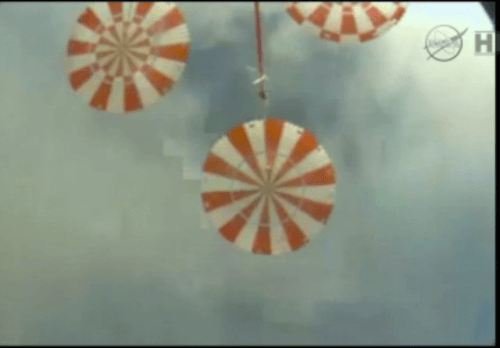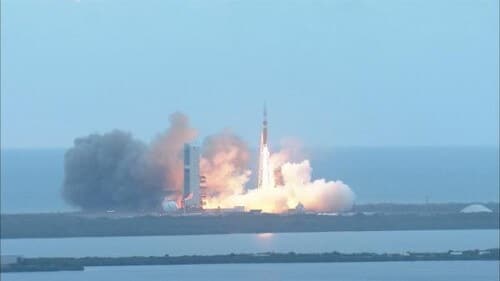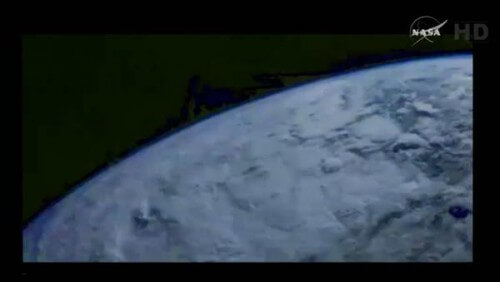Orion's first test launch operation was successful without even a single malfunction

Orion spacecraft launch - infographic and photo gallery
It was a busy day for space flight enthusiasts. For the first time since the end of the shuttle era in 2011, a spacecraft planned to be manned took off for the first test flight.
Many systems were tested during the flight which lasted four hours and 24 minutes. First, the Delta 4 launch vehicle in its heavy configuration, the use of the second stage almost throughout the journey until just before entering the atmosphere, the spacecraft itself with all its systems (with the exception of the crew module which was a dummy module, a real module was built these days by the European Space Agency actually), and systems GPS, a system for rescuing the passengers in case of a launch malfunction, and of course the heat protection system at the entrance to the atmosphere, the guides whose three generations open, do their job of slowing down the spaceship and direct their way to parachutes suitable for more compressed air.
Finally, the landing gear and the airbag system that should keep the passenger cabin stable while waiting for rescue in the ocean.
In this article, we bring, from the end to the beginning, the updates that accompanied the short operation from the launch to the preparations for rescuing the spacecraft from the ocean water and transporting it by tugboat to the port of San Diego.
update 19:30, The battery was turned off, the control center in Houston announced the end of its operation in this operation with confirmation that no dangerous substances leaked from the Orion spacecraft and that the rescue teams could use it and transport it by ship to the port of San Diego. From there she will be transferred to Cape Canaveral for a comprehensive examination.
עDakhon 19:20 - At 19:30 the control center in Houston will transmit a command to the computer of the Orion spacecraft to turn off the battery, to allow the rescue teams to transfer it safely to the ship's anchorage. This actually ends the operation. During the additional hour of battery operation, the Lockheed Martin personnel pulled the heat sensor data from the spacecraft's computer during the penetration into the atmosphere, a time when, as I recall, contact with the spacecraft was lost. The two parachutes that were located and deployed from the water will also be taken to analyze their condition.
18: 50 Update - The landing was only about 2.5 km east of the planned location.
18: 40 Update As aircraft and ships approached the landing site it appeared that only two of the five airbags inflated as planned. Despite this, Orion stood on her stomach. Later in the day she will travel aboard a US Navy ship Anchorage to the port of San Diego. The journey, about a thousand kilometers long, will take several days.
18: 30 Update
At 18:29, Orion landed safely, after the penetration into the atmosphere went smoothly, and the parachutes opened at the exact time set for them. All five airbags inflated as planned and she is now stable and awaiting rescue. In fact the whole operation went without a single glitch.
Update 18:22 - Orion has entered the atmosphere. Temporarily lost the telemetry connection as expected. 18f24 Cement the observation sees, the connection is back
17: 50 Update
NASA updates that during the landing, the thermal protection system of the passenger cabin, which consists of 970 protective tiles in two layers, will be tested to prevent damage in the event of a crack or a meteorite hitting one of the tiles.
17: 15 Update - At 17:05, Orion reached the height of its orbit, 3,132 nautical miles or 5,800 km as planned. Next steps: separation of the crew module from the service module at 17:30, and landing an hour later. A NASA unmanned aircraft is waiting for Orion at the predicted landing area to film the entire process. Orion's second stage will separate and fire its engines a third time to land in the Pacific Ocean away from the spacecraft itself.
Update 16:40.
The passage through the Van Allen Belt went smoothly. All the instruments of the spacecraft work as they should. Orion began transmitting images of the Earth from a distance of about 4,500 km.
16: 08 Update
Starting the engine at 16:00 and burning it for 4:40 minutes was successful. The second stage then separated from the spacecraft and Orion made her way alone. In the next few minutes, it will cross the Van Allen belt, and some of its instruments will measure the level of radiation experienced by the spacecraft at each point.
15: 50 Update
A more accurate assessment of the landing location will be made after the spacecraft completes crossing the Van Allen Belt,
Around 16:10 for 10 minutes her cameras will be turned off.
15: 35 Update
The second activation of the second stage engine is expected at 16:00 Israel time. The engine will be activated for 4.5 minutes and will raise Orion to an altitude of 5,800 km. On the way there, even before ignition, it will cross the radiation belt - the Van Allen belt. The spacecraft is expected to arrive there around 17:05 and transmit images in which the Earth should appear as a disk. After that, it will begin its journey down and cross the Van Allen Belt for the second time.. When its engines are activated in preparation for returning to Earth, at around 18:20, it will begin the landing operation that will last about 8 minutes, during which the three parachutes will open. Two aircraft carriers of the US Navy are waiting at the landing area expected to be rescued from the sea.

14: 35 Update
Launch part of the Orion spacecraft on its first test flight EFT-1. After repeated postponements yesterday, NASA, ULS and Lockheed Martin managed to carry out the launch at the time when the launch window opened - 07:05 EST 14:05 Israel time.
The spacecraft ascended for fifteen minutes to a low orbit around the Earth, only one hour and 55 minutes after the launch, the second stage of the heavy Delta 4 rocket is ignited again, for about four minutes. Therefore, it will perform the elliptical orbit at a relatively low altitude and only for the second time will it rise to an altitude of about 5,800 kilometers with the help of the second stage, and then return to land in the Pacific Ocean near the Baja California peninsula.
During its stay in the higher orbit, Orion will cross the Van Allen Belt, the radiation belt that surrounds the Earth. The engineers plan to turn off the spacecraft's cameras during the transition.
A spaceship without a destination
As we mentioned in previous articles, Orion is actually the replacement of the space shuttle. Today the experiment is unmanned and the spacecraft is full of sensors that will report exactly what the astronauts might feel, but later it may take off for a manned flight.

The only question is where it will take off. The International Space Station is expected to receive passenger transportation service and equipment from the companies SpaceX and Boeing that won the tender. There are currently no plans to return to the moon or send humans to Mars. The only launch in question is the following of an asteroid into orbit around the moon, which will be done by a robotic spacecraft. When the spacecraft and the asteroid enter orbit around the moon, astronauts will fly to it aboard Orion and drop samples from it.
Many critics argue that if NASA and Congress had not succumbed to the pressures of the giant companies, it might have been possible to think of creative and cheaper solutions. However, the technology is currently being tested. If it is safe, maybe this will make it easier for the decision makers to send humans on long flights.
Broadcast live streaming video on Ustream
Live broadcast from NASA TV
